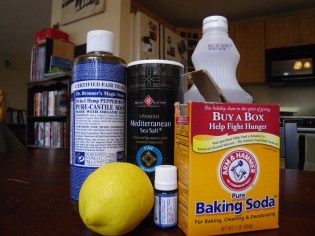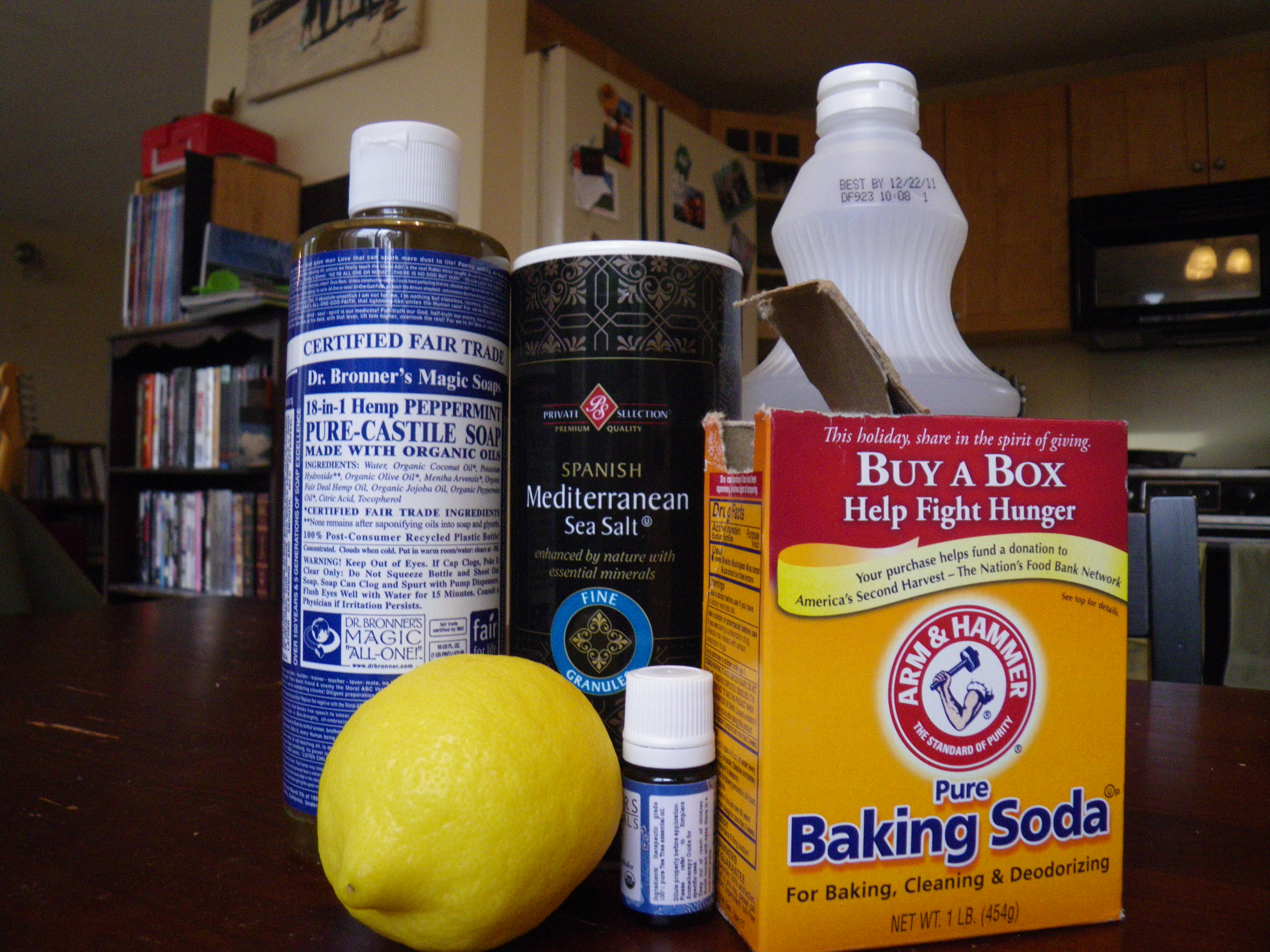
Natural born cleaners. (Photo by Elisabeth Kwak-Hefferan.)
Things I know, but wish I didn’t: Cake frosting is full of trans fat. Too many martinis can give you cancer [PDF]. Zillions of mites make their homes in our eyebrows. And, of particular concern during spring-cleaning season, common household cleaning products contain a host of nasty stuff.
What a buzzkill. Just as I can’t in good conscience eat spoonfuls of cake frosting straight from the jar, neither can I simply squirt easy-to-find, grime-zapping conventional cleaners all over the counters and be done with it. Up ‘til now, I’ve addressed this problem with nontoxic (if still store-bought) products from the likes of Seventh Generation and Method. But this year, I’ve decided to take the natural cleaning thing the next logical step, which explains why I spent the other night rubbing half a lemon into the shower tiles.
That’s right, I’m going DIY. I’ve heard about people using homemade cleaning concoctions for years, but I dismissed the practice to those much crunchier than I am (you know, dreds, sarongs, an open box of baking soda on the sink where others have toothpaste). Worse, I assumed that some hippie salve made of salt and lavender oil could never get the job done. But now that I know better, it’s hard to argue with using cheap, barely processed cleaning recipes to give the apartment that special sparkle — if they actually work, that is.
No better way to find out than to try it, right? So this week, I embarked on a personal journey into the world of homemade cleansers. And to my considerable surprise, they were awesome. Well, most of them were. I’ll never go back.
Test 1: All-purpose cleaner (2 cups water + 3 teaspoons Dr. Bronner’s castile soap + 1 teaspoon tea tree oil)
I began with this twist on the ever-popular all-purpose spray. The tea tree oil gives this potion a natural antibacterial kick, while the mild castile soap lends cleaning prowess and a delightful peppermint scent to help combat the tea tree stank (reminiscent of grandmas’ closets everywhere).
First up: the kitchen table. Armed with a moistened, old cotton sock as a rag, I sprayed my cleaner all over the table surface and went to work. A few wipes dissolved mystery smudges and cat paw prints alike, leaving a pleasant sheen. Encouraged, I moved on to a kitchen counter and the sink itself. In both cases, grime came off with a minimum of effort. Even better: The lingering smell (which, relax, isn’t really all that bad) faded away after a few hours.
Verdict: Excellent. The spray shall assume the throne of the master cleanser in this house.
Test 2: Counter scrub (kosher salt + vinegar)
I approached this sour mixture with a bit more trepidation, but still applied it to a section of the counter with the scrubby side of a sponge. Vinegar is one of the most popular kids at the homemade-ingredient party, popping up in all kinds of recipes for its acidic, mold-killing nature and instant ability to transport us back to Easter egg-dyeing sessions of youth. (The salt adds an abrasive edge.)
A thorough wipedown with this stuff left the counter looking clean enough, but I clearly didn’t rinse it well enough afterwards. That’s a gentle way to say, “turned the counter into a salt lick,” which is what I actually did.
Verdict: Pass. No better than the all-purpose spray, but with gritty side effects.
Test 3: Baking soda scrub (baking soda + enough water to form a wet paste)
Now here’s a challenge: Clean the crusties from my neglected stovetop. As baking soda is the prom king to vinegar’s prom queen, beloved for its hardcore scouring abilities and anti-fungal nature, I figured the big BS would be up to the job.
Turns out I was right — sort of. When spread across the main stovetop, scrubbed off, and rinsed, this paste left the metal practically gleaming. But the removable trays under the burners proved a tougher opponent. Some of the blackened crud did loosen with vigorous scrubbing, but not nearly all. I was left with an arm cramp and cleaner — but not spotless — trays. Even an overnight soak in the paste couldn’t finish the task.
Verdict: Good. This stuff works like a charm on less-than-dire cleaning problems.
Test 4: Bathroom scrub No. 1 (lemon juice soak, then ½ cup baking soda + enough castile soap to form a toothpaste-like mixture)
Ah, the bathroom, the corner of our homes most plagued by dirty, stinky, mildewy offenses. If DIY products were ever to earn their place as a viable option, they’d have to prove equal to the tasks in here. Namely: a troublesome orange streak that had formed between my shower tiles.
I prepped the area by energetically rubbing half a lemon into the streak — as all good DIY-ers know, lemon juice is famed for its stain-reducing citric acid. After 10 minutes or so, I returned with a scrub brush and the pepperminty paste. It was a bit tricky to get the paste to stick to the wall, but once I used my fingers to jam it in the crevices between tiles, every bit of the orange grime lifted right off.
Verdict: Excellent (and lemony fresh).
Test 5: Bathroom scrub No. 2 (baking soda + kosher salt + water)
I took this final salve to the tub walls. At first, it didn’t look to be doing much. But after scrubbing and rinsing off the salty residue, the water flowed brown. Eeew. Compared to the freshly-cleaned section, the rest of the tub was suddenly a pit of infamy. I gave the whole thing a second going-over, just to be safe, until the rinse came away clear.
Verdict: Excellent. Gentle yet abrasive, with a pleasant non-odor.
The whole homemade cleaner project went so well, I’m adding it to another list. Things of which I was once skeptical, but now embrace: Harry Potter. Lentils. Rick Santorum (oops, wrong list). But definitely DIY cleaners.
How about you? Have any favorite homemade cleaning brews?



